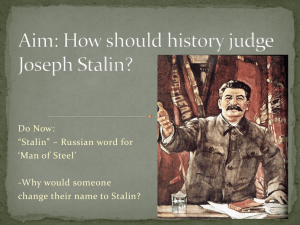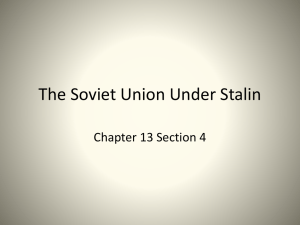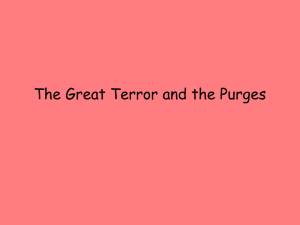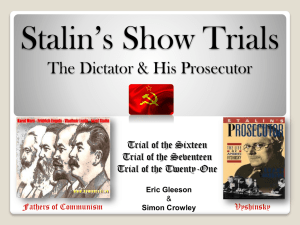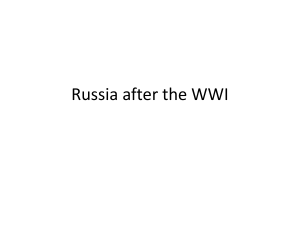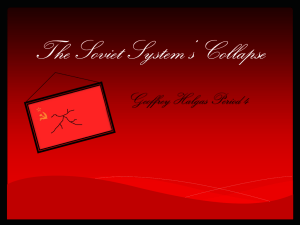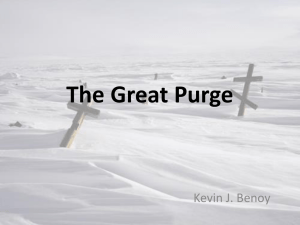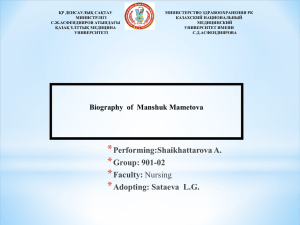Stalin the Last Years
advertisement
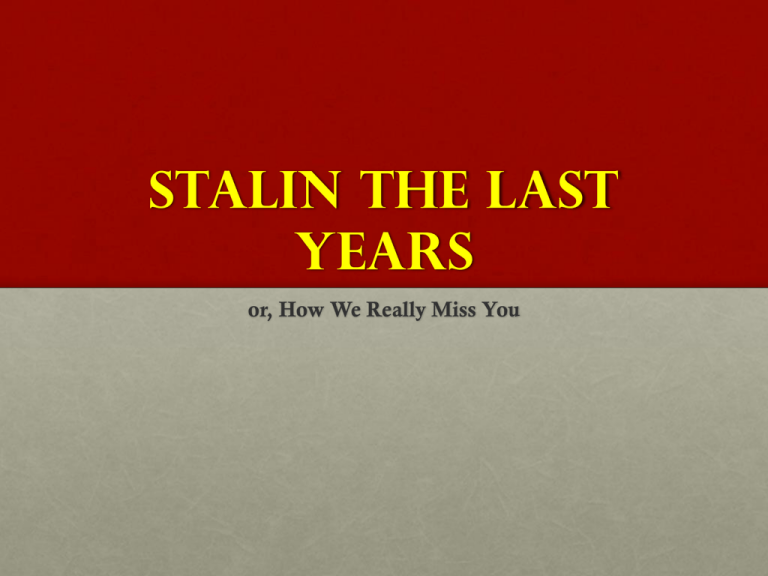
Stalin the last years or, How We Really Miss You The great patriotic war • 22 June 1941: Operation Barbarossa, the German invasion of the USSR • Soviet reports on German build-up • Stalin reluctant to acknowledge this was a genuine threat of invasion • British counter-intelligence distorted information on German maneuvers • British hoping to precipitate Soviet response to what appeared to be provocative German actions • Hitler would not risk 2-front war The great patriotic war • Stalin rejects espionage reports of imminent German invasion and reports from contacts in German Luftwaffe that invasion was planned • German disinformation • continued to offer military and economic assistance to Germans up to the eve of the invasion The great patriotic war • Stalin: Rational or Delusional? • Ian Kershaw: • Stalin had limited options • Soviet military not strong enough for pre-emptive strike on Germany • only hope was line of least resistance in attempt to avert German aggression The great patriotic war • Stalin: Rational or Delusional? • victim of his own propaganda • had portrayed Nazi-Soviet Non-Aggression Pact as result of masterly diplomacy • could not admit he had failed & taken advantage of by Hitler The great patriotic war • Stalin: Rational or Delusional? • for 2 days Stalin stayed in his dacha given no orders or instructions • no one could act to direct resistance to Germans • Soviet forces reeled from surprise and power of German offensive The great patriotic war • Stalin: Rational or Delusional? • Biggest Mistake: • not misreading German intentions • decimating Red Army high command in his Purges, 1938-1939 The great patriotic war • Operation Barbarossa • Germans • • • • 3,000,000 troops 500,000 motorized vehicles 4,000 tanks 3,000 aircraft • Soviets • • • • matched German troop numbers 4X the tanks 3X the aircraft almost collapsed while forces organized and moved The great patriotic war • Why did Operation Barbarossa Fail? 1. Stalin Recovered his Nerve by 3 July 1941 2. Barbarossa launched late—June instead of May 3. General Winter 4. Nazi Racism The great patriotic war • Why did Operation Barbarossa Fail? • Stalin Recovered his Nerve by 3 July 1941 o 3 July 194: radio appeal to defend Mother Russia— appeal to nationalism o adopted scorched earth policy o remained in Moscow in October 1941 when it looked like it would fall to Germans The great patriotic war • Why did Operation Barbarossa Fail? • Barbarossa launched late—June instead of May o Barbarossa was delayed by 6 weeks o primarily need to divert German forces to help Mussolini in Greece The great patriotic war • Why did Operation Barbarossa Fail? • General Winter o Autumnal rains brought thick mud o December 1941 counter attack by Marshall Zhukov o Germans not prepared for winter warfare—clothing, supplies, lubricants, food The great patriotic war • Why did Operation Barbarossa Fail? • Nazi Racism o many Soviets at first welcomed Nazis as liberators o many were seen as ethnic untermenschen—especially Ukraine o met with German ferocity, superiority & barbarism The great patriotic war • Character of the War • war of attrition—w/Soviet forces drawing Germns deeper & deeper into Russia before counter-attacking • Casualties: height of war, 1941-1942, averaged 15,000 killed/day • 5,500,000 became POWs—4,000,000 shot or died in captivity • brutal treatment form own leaders The great patriotic war • Character of the War • “1. Commanders and workers who during battle desert or surrender to the enemy are to be considered malicious deserters. Their families are to be arrested as the relatives of deserters who have broken their oaths of service and betrayed their motherland. All commanders and commissars are to shoot deserters on the spot.” • “2. Units and sub-units that are surrounded by the enemy are to fight selflessly to the last man.” The great patriotic war • Character of the War—The Battle of Stalingrad • became symbol of Russian resistance • Stalin demanded city be defended to the death • Hitler: “’The Führer orders that on entry to the city the entire male population be done away with.’” • on entry Germans met such fierce fighting that the besiegers became the besieged—”fight to last soldier and the last bullet.” The great patriotic war • Character of the War—The Battle of Stalingrad • Germans deprived of supplies and reinforcements • surrendered on 31 January 1943 • 200,000 German KIA • 91,000 POWs—only 6,000 survive captivity • Hitler’s Sixth Army completely destroyed • broke myth of German invincibility The great patriotic war • Character of the War—The Battle of Stalingrad • USSR encircled German forces • more than 1,000,000 Soviet KIA • life expectancy of Soviet soldier on the front—24 hours The great patriotic war • Character of the War—The Battle of Kursk • 5 July 1943 Germans launched Operation Citadel in effort to take advantage of Soviet defensive positions • Germans: 700,000 troops; 2,400 tanks, 1,800 aircraft • USSR: 1,300,000 troops, 3,400 tanks, 2,100 aircraft • final German strategic offensive in the East The great patriotic war • Character of the War—The Battle of Kursk • largest series of armored battle in history • largest single-day aerial battle of the war • 12 days of battle before Germans broke off the fighting • from here on Soviets would have initiative during war The great patriotic war • Impact of War on Soviet People • 1/2 Soviet population under German occupation • 1/3 Soviet industry in German hands • Iron & Steel Production declined 60% • Rail system reduced by 40% • livestock reduced by 60% • grain stock reduced 40% The great patriotic war • Wartime Reorganization • Much of Soviet industry disassembled and relocated in eastern parts of country • July-December 1941: 2593 industrial enterprises moved using 1.5 million rail cars The great patriotic war • Wartime Reorganization • all adults not in essential war work conscripted • 1944: over 2,000,000 women in Red Army, including some all-women units • women, children & elderly forced into industrial labor—arms production top priority—over 50% national income • aided by Lend-Lease from USA The great patriotic war • Stalin in the War • blamed military failures on internal sabotage • persecuted those deemed responsible • many Soviet troops had deserted • many Soviets had fought for Germans • forms basis to justify new purges of the army at the end of the war The great patriotic war • Stalin in the Post-War • more paranoid at end of the war • Stalin demanded repatriation of released Allied POWs to their countries of origin—many Soviets citizens had fought w/Nazi—Allies resisted, but eventually agreed • mass execution of returned POWs • blame extended from individual to communities, i.e. virtual elimination of Cossacks • Soviet soldiers captured by Germans were considered to have collaborated—executed or into camps The great patriotic war • Stalin in the Post-War • Stalin as War Hero • portrayal ordered by Stalin—propaganda The great patriotic war • Religion in the War & After • Stalin emphasized patriotism & nationalism during WW II, not politics • eased persecution of churches—Russians still had deep religious instinct • Church leaders responded by turning religious services into patriotic gatherings—passionate defiance of Germans & rally behind the great leader, Stalin The great patriotic war • Economy in the War & After • Scorched Earth Policy = survival • shift to total war economy • “We must strengthen the Red Army’s rear, subordinating all our work to this end. All our industries must be made to work with greater intensity, to produce more rifles, machine-guns, cartridges, shells, planes…”—Stalin, extract from his ‘Mother Russia’ speech, 3 July 1941 The great patriotic war • Economy in the War & After • severe industrial & economic losses (see previous slides) • Soviet expansion had centered on area west of Ural Mountains—most vulnerable to German attack • 1942: 50% of national income devoted to military tasks • vast relocation of Soviet industries to the East Wartime Production WARTIME PRODUCT 1940 = 100 1941 1942 1943 1944 Nat’l Income 92 66 74 88 Total Industry 98 77 90 104 Armaments 140 186 224 251 Fuel 94 53 59 75 Agricultural 42 38 37 54 The great patriotic war • Economy in the War & After • Fourth Five-Year Plan (1946-1950) • • • • restore production to pre-war levels achieved in 3 years mostly in heavy industry unable increase agricultural production • economy remained unbalance • little effort to adapt to new, progressive industrial techniques • projects that gave sense of pride, not efficiency— bridges, dams • Stalin’s Grand Projects of Communism--propaganda The great patriotic war • Economy in the War & After • Fifth Five-Year Plan (1951-1955) • maintained emphasis on heavy industry • iron, steel, oil, electricity all doubled • no increase in standard of living • no success in agriculture • economy remained unbalance • • • • • • agriculture under capitalized heavy subsidies shortages black market accommodations scarce wages not above subsistence The later purges 1941-1953 • The Leningrad Affair • dispensed with Central Committee & Politburo— removes even semblance of restriction on his authority • accusation that prominent members of Communist Party of treason—many heroes of siege of Leningrad • from Leningrad Party Cell could form a competitive anti-Soviet organization The later purges 1941-1953 • The Leningrad Affair • Pyotr Popkov, Aleksei Kuznetsov, Nikolai Voznesensky organized trade fair to boost post-war economy & support survivors of siege • accused of trying to use Moscow budget allocations to benefit business ventures—embezzlement The later purges 1941-1953 • The Leningrad Affair • three men above & two others sentenced to death on false charges • 2,000 public officials dismissed; 200 along w/family repressed • entire leadership of Leningrad govt. & political leaders replaced w/ men loyal to Stalin The later purges 1941-1953 • The Doctors’ Plot, 1952-1953 • biggest anti-Semitic persecution of Stalin’s rule • influences: • • • • Israel ties to West worry about Jewish nationalism increasing suspicions of physicians daughter’s affair w/Jewish man The later purges 1941-1953 • The Doctors’ Plot, 1952-1953 • 1952: aging & ailing leaders of Soviet dying • “They die one after another… die so quickly! We must change the old doctors for new ones.”—Stalin, 1952. • Jewish-dominated medical profession had planned to murder Stalin and other Soviet leaders • preparations for massive pogrom The later purges 1941-1953 • The Doctors’ Plot, 1952-1953 • those interrogated coerced to produce evidence proving Stalin’s personal physician plotted to assassinate him & other leaders • “Every Jewish nationalist is the agent of the American intelligence service. Jewish nationalists think that their nation was saved by the USA (there you can become rich, bourgeois, etc.). They think they’re indebted to the Americans. Among the doctors, there are many Jewish nationalists.”— Stalin, 1 December 1952 • massive purge only halted by Stalin’s death The later purges 1941-1953 • Summary of Stalin’s Purges • 1940: occupation of Baltic states—2 million deported • 1941: deportation of various national groups to Siberia (Germans, Ukrainians, Chechens, etc.), about 1/3 died • 1944-1946: screening of returned POWs & those who lived under German occupation—10 million to labor camps; 5 to 6 million died in captivity • 1947-1953: various purges resulted in 1 million deaths The later purges 1941-1953 • Summary of Stalin’s Purges—Motivations • desire to impose absolute authority—bring all aspect of state & Party control under his reigns • achieved—purges continued • targeted & destroyed people not for what they did, but for what they could do The later purges 1941-1953 • Summary of Stalin’s Purges—Motivations • “As he’d got older, my father had begun feeling lonely. He was so isolated from everyone that he seemed to be living in a vacuum. He hadn’t a soul he could talk to. It was the system of which he himself was the prisoner and in which he was stifling from emptiness and lack of human companionship.”— Svetlana Alliluyeva, Stalin’s daughter • indicates a deeply disturbed & distrustful mind The later purges 1941-1953 • Summary of Stalin’s Purges—Overview • Robert Service, biographer of Stalin: “’Nowadays virtually all writers accept that he initiated the Great Terror.’” • Service & others recognize complicity of those who carried out the purges • opportunity to settle old scores • advancement due to new vacancies • popular support from those who did not want USSR slip back into weakness The later purges 1941-1953 • Summary of Stalin’s Purges—Overview • Richard Overy: “’the law of violent proletariat revolution is an inevitable law of the revolutionary movement’ linked to Lenin’s declaration that the task of Bolshevism was ‘the ruthless destruction of the enemy. • purges were natural progression • concept of individual rights or civil rights severely undeveloped in Tsarist Russia nor addressed by Lenin & the revolutionary movement • Lenin had re-emphasized the necessity of obedience to central authority

